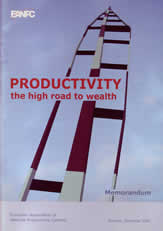|
|
|
Close Help | ||||||||||||||

|
|
 |
4.5 Work organisation and learning organisations The way in which work is designed — from the physical lay-out of the individual workplace through to the way in which the enterprise is ‘articulated’ with its environment, notably its suppliers and customers — is a significant source of productivity development. And, on the other hand, the quality of work organisation is influenced by a number of factors, one of which is productivity development. Particularly as, over the past few years, the rate of economic growth has declined, competition between enterprises has intensified and the pace of economic structural change has quickened, the quality of work organisation has become more important as a factor influencing productivity development. In this respect, new forms of employment, such as part-time work, project and tele-working, virtual and mobile work play as important a role as forms of work in which the workforce has more freedom of initiative, enhanced skills and greater responsibility for their collective work (such as team-working, one-off projects and working time arrangements). The exponential growth of applications information and communication technology has enabled cooperation between people on distance through virtual teams, in cyberspace: a worker is able to work independent of place and time and communicate with colleagues and customers. There are four forms of virtual work: Mobile work; Virtual teams; Shared services, and Virtual networks, of which mobile work is the most popular. Virtual work can increase productivity but research has shown that mobile work for instance may lead to increasing work load and hence work stress. Thus not all changes have been for the better: not only work intensification may occur because of innovation but also de-skilling has continued to occur as new products and processes replace those existing. Enterprises have reduced their hierarchical levels, decentralised responsibility (‘empowered’ their workforces) and sought greater flexibility in their organisation. These and other change processes have been driven forward by a range of organisational design and management approaches. These include programmes for improving the linkages between living and working conditions — family life is clearly a ‘productivity factor’ for mothers, but also for a growing number of fathers — as well as a variety of management philosophies such as socio-technical systems design, lean production, the learning organisation, just-in-time management, business process re-engineering, and total quality management. Moreover, the skills’ demands on the workforce have increased. It is not just that new skills have to be learned, but also that old skills have in some cases to be renewed and, in others, to be unlearned. The productivity challenge is to ensure that the greatest possible proportion of the existing workforce is willing and able, to continuously upgrade its individual and collective skills. And this can only be achieved by a judicious blend of learning off-the-job and on-the-job. To promote such synergy, work must be designed in such a way that it is conducive to the application of the more theoretical off-the-job training. Thus does ‘the quality of work organisation’ depend on both structures (the actual shape of the organisation) and processes (the changing skills — both collective and individual — which people actually use to satisfy their customer). The important contribution of workers in innovating and developing the work organisation and organisational learning is increasingly recognised. Effective communication channels can identify early problems in work design and more genuinely empower workers to take on more responsibilities as work becomes more decentralised. |
 |